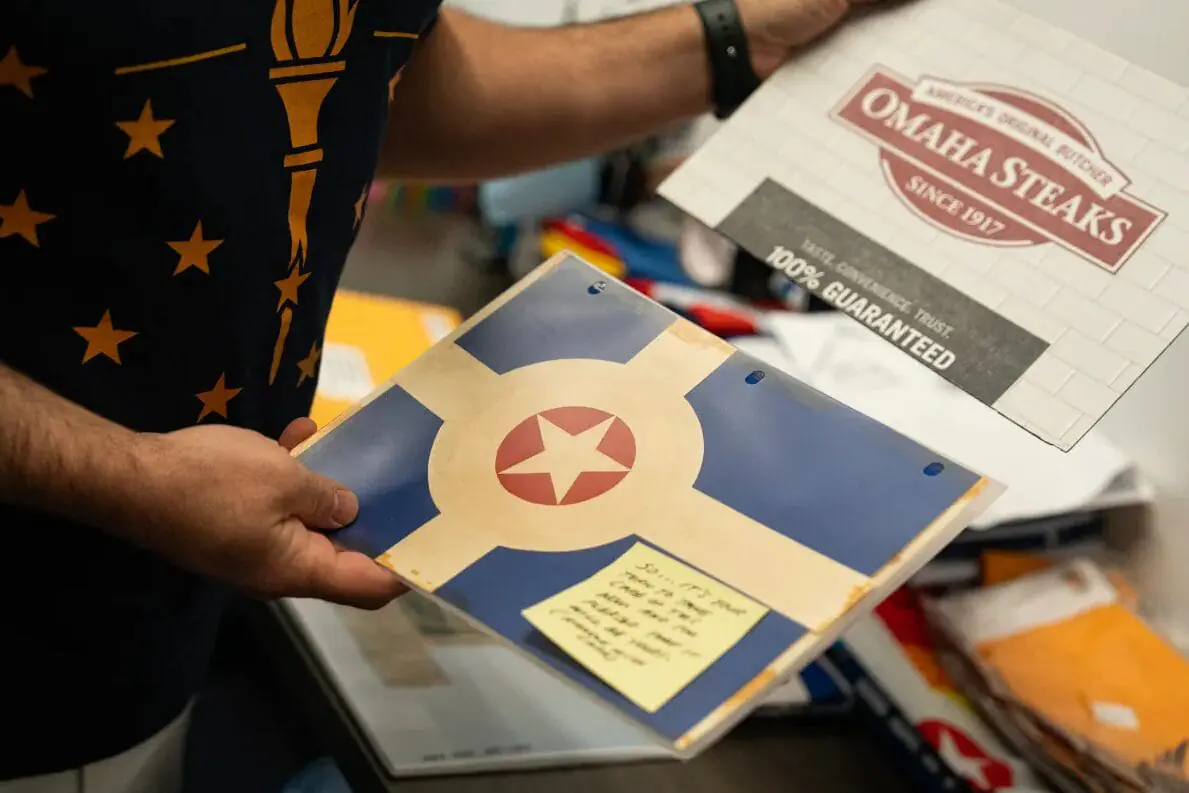How a piece of Indianapolis flag history came back home again
(MIRROR INDY) — The Indianapolis flag you see today is not as it was originally designed.
The red, white and blue mock-up that Roger E. Gohl entered into a contest in 1962 still sported the star and stripes representing the heart of the city.
But it was set slightly to the left, a choice to make the flag look better alongside the similarly asymmetrical American one.
The city “changed it last minute,” said Michael Green, founder and CEO of Indianapolis-based Flags For Good. Gohl, he learned, didn’t care much. “He just was like, ‘It’s still a good flag. Whatever.’”
That mock-up — roughly the size of a piece of printer paper — unexpectedly came into Green’s position after he and the now-late Gohl struck up a conversation.
“I said, ‘No, that belongs in a museum,’” Green said, “but he had already put it in the mail.”
The small package arrived with little protection, just the cardboard from an Omaha Steaks package to keep the paper from bending.
Included was a note in precise handwriting: “It’s your turn to take care of this now.”
History of the flag and its maker
At the time Indianapolis began searching for a new flag design, the current one had been in place for nearly half a century — technically.
Although adopted by the city council in 1915, it never gained popularity. That flag looked like a mashup of our modern city flag and the U.S. one.
So in 1962, city leaders hosted a contest. The winner would receive $50 and lunch with the mayor.
Out of 75 submissions, judges chose the design submitted by Gohl, who was 18 at the time. He would later tell a reporter that he entered the contest “because I wanted the 50 bucks.”
The fact that those circumstances produced such a well designed flag is lucky, said Ted Kaye, secretary of the North American Vexillological Association and author of “Good Flag, Bad Flag.”
A good flag, according to the association, must be simple and distinctive, have meaningful symbolism, use two to three colors and have no lettering or seals.
With its recognizable homage to the heart of the city, Kaye said, “the Indianapolis flag meets all the creators of a good design.”
He’s not the only one who thinks so highly of the design. In a 2004 survey of association members and members of the public, Indianapolis’ ranked eighth out of 150 city flags.
“Indianapolis’ is just super in that way because it’s discernible and it’s memorable,” Kaye said.
A local flag enthusiast
Shortly after winning the contest, Gohl left Indianapolis for California, where he spent the rest of his life.
He died May 21, 2024, at the age of 80.
Before he died, Green reached Gohl by phone hoping to interview him about the design.
“He thought I was a telemarketer,” Green said. “He didn’t believe flag people existed.”
Green plans to use the recorded interviews for a video about the Indianapolis flag on his YouTube channel.
Green had a penchant for flags long before he started Flags For Good.
“I traveled a lot as a kid,” Green said. “I was going to all these places, like collecting their flag and attaching those memories to flags.”
He studied graphic design at Texas A&M University, where he later worked in roles managing the school’s branding. His interest in flags persisted.
“Graphic design is studying how to visually communicate,” Green said. “They can communicate such deep meanings the simplest way possible. I could nerd out about that for a while.”
He started Flags For Good in June 2020, in the aftermath of the murder of George Floyd by a Minneapolis police officer. Green searched for a Black Lives Matter flag to show his solidarity with the movement.
But he struggled to find a company that didn’t also sell Confederate flags. So he started producing a few flags of his own, in what he thought would be a two-week project to fill up his spare time during the COVID-19 pandemic lockdown.
Nine months later, he found himself choosing between his marketing job and flags. He chose the latter.
“I think a lot of people resonated with the why I started it, which was (that) I wanted to find a flag company that believed in what they sold,” Green said.
The company sells hundreds of designs in multiple sizes, including flags based on causes, countries, seasons and sports. A dollar from each sale is donated to charity, and the company has donated more than $250,000 so far.
Currently based out of a small fulfillment center at 16 Tech, Green plans to open a brick-and-mortar location that will act as part museum, part store.
There, he will display Gohl’s contest entry after it spent decades on the West Coast.
“It’s finally found its home, back home again in Indiana,” he said.
Emily Hopkins is a Mirror Indy reporter focused on data and accountability. You can reach them on phone or Signal at 317-790-5268 or by email at emily.hopkins@mirrorindy.org. Follow them on most social media @indyemapolis or on Bluesky @emilyhopkins.bsky.social.
